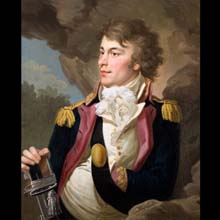
material: oil on canvas
dimensions: 70 x 58 cm
description: Józef Korwin-Kossakowski (1772–1842) was Brigadier-General and later adjutant to Napoleon I. He served in the National Cavalry of the Grand Duchy of Lithuania and participated in the campaign of 1792. Thanks to the support of his paternal uncle, Hetman Szymon Kossakowski, he was promoted during the time of the Targowica Confederation. He supported the Kościuszko Uprising and, after its fall, emigrated to Paris, where he met Napoleon. After Bonaparte entered Lithuania, Kossakowski was appointed Brigadier-General, and later the adjutant to the Emperor. He also became a member of the Guard of Honour. Kossakowski took part in the campaigns of 1812–1814. In 1815, after Napoleon’s fall, he withdrew from the military service, returned to Lithuania and devoted himself to collecting. The portrait of twenty-two-year-old Kossakowski is reminiscent of English portraits, which depicted the sitter surrounded by nature. Kossakowski is hence portrayed against a landscape, leaning against a rock in a casual pose, with curls flowing in the air. English portraits were painted with fluid, light brushstrokes, creating a visible painterly texture. However, Wojniakowski, who received education only in Poland, applied these features in a schematic and simplified way. Barbara Ciciora
exposition: The Gallery of 19th Century Polish Art in Sukiennice,
The Cloth Hall, 1, Main Market Square
key: Enlightenment >>>
dimensions: 70 x 58 cm
description: Józef Korwin-Kossakowski (1772–1842) was Brigadier-General and later adjutant to Napoleon I. He served in the National Cavalry of the Grand Duchy of Lithuania and participated in the campaign of 1792. Thanks to the support of his paternal uncle, Hetman Szymon Kossakowski, he was promoted during the time of the Targowica Confederation. He supported the Kościuszko Uprising and, after its fall, emigrated to Paris, where he met Napoleon. After Bonaparte entered Lithuania, Kossakowski was appointed Brigadier-General, and later the adjutant to the Emperor. He also became a member of the Guard of Honour. Kossakowski took part in the campaigns of 1812–1814. In 1815, after Napoleon’s fall, he withdrew from the military service, returned to Lithuania and devoted himself to collecting. The portrait of twenty-two-year-old Kossakowski is reminiscent of English portraits, which depicted the sitter surrounded by nature. Kossakowski is hence portrayed against a landscape, leaning against a rock in a casual pose, with curls flowing in the air. English portraits were painted with fluid, light brushstrokes, creating a visible painterly texture. However, Wojniakowski, who received education only in Poland, applied these features in a schematic and simplified way. Barbara Ciciora
exposition: The Gallery of 19th Century Polish Art in Sukiennice,
The Cloth Hall, 1, Main Market Square
key: Enlightenment >>>












